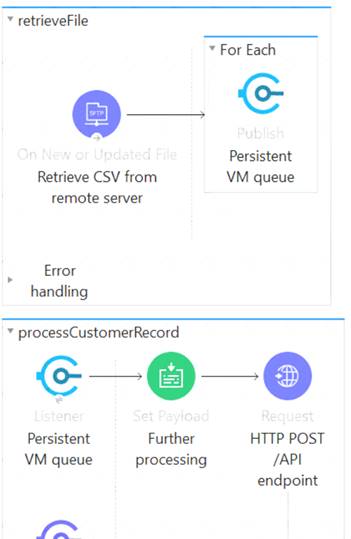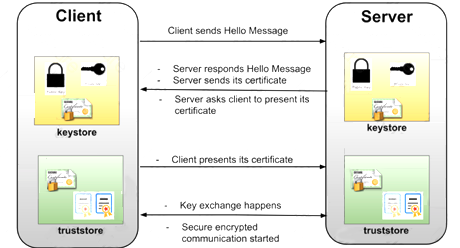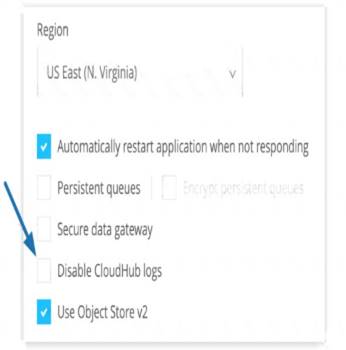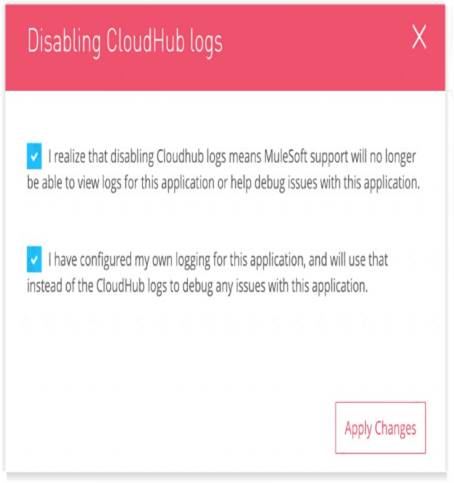Refer to the exhibit.
This Mule application is deployed to multiple Cloudhub workers with persistent queue enabled. The retrievefile flow event source reads a CSV file from a remote SFTP server and then publishes each record in the CSV file to a VM queue. The processCustomerRecords flow’s VM Listner receives messages from the same VM queue and then processes each message separately.
How are messages routed to the cloudhub workers as messages are received by the VM Listener?
Correct Answer:
B
What requires configuration of both a key store and a trust store for an HTTP Listener?
Correct Answer:
A
1- way SSL : The server presents its certificate to the client and the client adds it to its list of trusted certificate. And so, the client can talk to the server.
2- way SSL: The same principle but both ways. i.e. both the client and the server has to establish trust betwe themselves using a trusted certificate. In this way of a digital handshake, the server needs to present a certificate to authenticate itself to client and client has to present its certificate to server.
* TLS is a cryptographic protocol that provides communications security for your Mule app.
* TLS offers many different ways of exchanging keys for authentication, encrypting data, and guaranteeing message integrity Keystores and Truststores Truststore and keystore contents differ depending on whether they are used for clients or servers:
For servers: the truststore contains certificates of the trusted clients, the keystore contains the private and public key of the server. For clients: the truststore contains certificates of the trusted servers, the keystore contains the private and public key of the client.
Adding both a keystore and a truststore to the configuration implements two-way TLS authentication also known as mutual authentication.
* in this case, correct answer is Support for TLS mutual (two-way) authentication with HTTP clients.
What aspect of logging is only possible for Mule applications deployed to customer-hosted Mule runtimes, but NOT for Mule applications deployed to CloudHub?
Correct Answer:
D
* Correct answer is To directly reference one shared and customized log4j2.xml file from multiple Mule applications. Key word to note in the answer is directly.
* By default, CloudHub replaces a Mule application's log4j2.xml file with a CloudHub log4j2.xml file. This specifies the CloudHub appender to write logs to the CloudHub logging service.
* You cannot modify CloudHub log4j2.xml file to add any custom appender. But there is a process in order to achieve this. You need to raise a request on support portal to disable CloudHub provided Mule application log4j2 file.
Graphical user interface, application, Word Description automatically generated
* Once this is done , Mule application's log4j2.xml file is used which you can use to send/export application logs to other log4j2 appenders, such as a custom logging system MuleSoft does not own any responsibility for lost logging data due to misconfiguration of your own log4j appender if it happens by any chance.
Graphical user interface, text, application, email Description automatically generated
* One more difference between customer-hosted Mule runtimes and CloudHub deployed mule instance is that
- CloudHub system log messages cannot be sent to external log management system without installing custom CH logging configuration through support
- where as Customer-hosted runtime can send system and application log to external log management system MuleSoft Reference:
https://docs.mulesoft.com/runtime-manager/viewing-log-data https://docs.mulesoft.com/runtime-manager/custom-log-appender
An insurance company is using a CIoudHub runtime plane. As a part of requirement, email alert should be sent to internal operations team every time of policy applied to an API instance is deleted As an
integration architect suggest on how this requirement be met?
Correct Answer:
D
As a part of business requirement , old CRM system needs to be integrated using Mule application. CRM system is capable of exchanging data only via SOAP/HTTP protocol. As an integration architect who follows API led approach , what is the the below step you will perform so that you can share document with CRM team?
Correct Answer:
C
Correct answer is Create WSDL specification using text editor SOAP services are specified using WSDL. A client program connecting to a web service can read the WSDL to determine what functions are available on the server. We can not create WSDL specification in Design Center. We need to use external text editor to create WSDL.